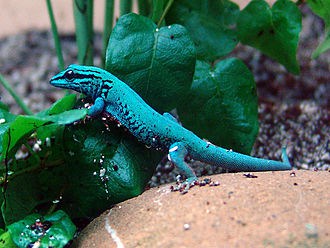Type the name of the breed you're looking for below
[wpdreams_ajaxsearchlite] Don't see the breed your're looking for? Click here and let us know!
Blue Dwarf Gecko
| Place of Origin and Range | Is only found in 8 km² (3 sq mi) of the Kimboza Forest in eastern Tanzania. |
| Description | Males are bright blue with heavy black throat stripes, visible pre anal pores, and hemipenile bulges. The females range from brown or bronze to bright green, and have little to no black on their throat. Females can easily be confused with juvenile or socially suppressed males that are also green, sometimes with a bluish cast. The underside of both sexes is orange. Colours of individuals vary according to mood and temperature. Males may range from black or grey to brilliant electric blue. Females may range from dark brown to brilliant green with turquoise highlights. |
| Morph Patterns Available | Yes |
| Adult Size | Can grow up to 3.5 in ( 9 cm ) |
| Accommodation | A minimum of two hides, a warm one and a cooler one, using their hides to "stalk" or wait for dinner. A day basking lamp(basking spot 80'F(27'C)or some snake owners prefer under tank heating. Also you want to include a bathing dish big enough for your lizard to climb in without overflowing. To improve shedding. 2 ft x 2 ft x 4 ft terrarium for an adult. Cover the sides of the cage when possible to prevent injury to your gecko from running into glass. |
| Lifespan | Can live 2- 8 years |
| Feeding / Diet | Eats insects, such as young crickets and fruit flies. |
| Other Considerations | Healthy geckos with appropriate living conditions shed regularly. They shed completely and often eat their shed to the point where the keeper may not even notice that the gecko has shed. Some geckos experience shedding problems occasionally and others chronically have difficulty shedding. Signs of shedding difficulty range from large sheets of shed clinging to the head, tail or limbs to residual shed left around the eyes, on the tail tip or the toes. This shed must be removed since it can cause constrictive damage to the extremities. All geckos require calcium to maintain strong bones and vitamin D3 to aid in metabolizing the calcium. Calcium is generally supplied in powdered form in a bowl, through dusted feeders or as an ingredient in fruit. |



